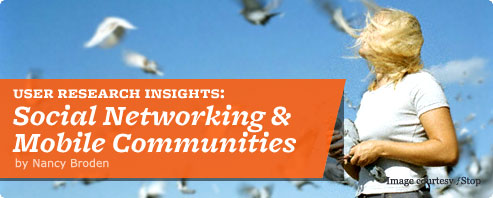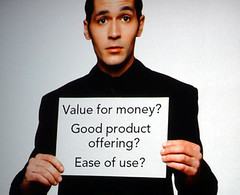
Social networking and user-generated content are, without a doubt, hot topics in the mobile sector right now. The marriage of social networking and mobile phones seems logical: our mobile phones are always with us and keep us connected to our networks all day, every day. We currently use our mobile phones to create and share content to a limited degree, and as our devices become more and more sophisticated the kinds of user-generated content we create and the means by which we share them will only increase. In anticipation of this wave, Web-based social networking sites like MySpace are moving into mobile hoping to increase their reach and popularity, while the ranks of startups are swelling with developers of wireless social networks or tools that facilitate mobile social networking. 3’s See Me TV in the UK has already shown that that video created and consumed on the mobile phone can be a popular proposition.
Despite the growing numbers of players in the mobile social networking space, questions abound about what constitutes a successful mobile social networking experience. What form will social networks take in the mobile context? How will desktop-based and mobile social networks co-exist, or will they? As a San Francisco-based interface strategy, design and development consultancy with a specialization in mobile, we at Punchcut spend a great deal of time pondering these questions and envisioning future-forward solutions for our clients. In order to inform our design efforts, we recently conducted a qualitative study of the social networking behaviors of 11 young adults living in the San Francisco Bay area. The purpose of the study was to gain an understanding of why young, socially connected individuals engage in social networking behaviors and how the use of a mobile device supports and fosters these behaviors.
Continue Reading »
Add this to digg, del.icio.us, etc.
Scott Weiss, the author of Handheld Usability (the book and blog), recently posted the results of a survey of over 800 New Yorkers on the importance of several factors when considering the purchase of a new phone. Weiss notes that the survey respondents value mobile ease-of-use 3 to 2 over appearance. “The finding is astounding, because it shatters the commonly-held believe that appearance is more important to consumers than usability”, he writes. After ease-of-use respondents considered appearance, internet access, MP3 player capabilities and mobile television features, in that order. Weiss adds, “the highest percentage of respondents (33%) rated Mobile Television Features and MP3 Player Capabilities as Neither Important nor Unimportant in their mobile phone purchase decisions”.
While I agree with his ultimate conclusion — that usability is a big deal and ease-of-use should be a goal of all handset manufacturers — I question drawing that conclusion based on the survey information provided.
Continue Reading »
Add this to digg, del.icio.us, etc.

This month, Google Labs released a new service called GOOG-411. A toll-free call will get you in touch with a friendly, natural-sounding robot asking you for your city, your listing or category, and then offer to connect you, give you address details, or send all those goodies to your phone via text message. The voice recognition is impressive and the overall flow is fairly speedy, though there are certainly redundancies that lengthen the overall process for the sake of usability (which in this case earns them points in my book). Luckily, there’s a cheat sheet for advanced users to blast past some of the menus.
GOOG-411 is a clever development effort on Google’s part as all of this infrastructure — maps, text messaging, business directory search — is already part of the Google suite of services and this mashup recipe sets them up with a solid core experience. Building on this service is only a matter of choosing which pieces will add to the user experience and not overly complicate its current simplicity. For example, I can easily imagine saying “Directions” and having step-by-step instructions of how to get there from where I am while leveraging my phone’s location data.
Continue Reading »
Add this to digg, del.icio.us, etc.
If you think Tamagotchi is past tense for virtual pet, think again. They’re connecting with some US partners to create a competitor to Disney Mobile and Firefly.
“Tamagotchi virtual pet now comes as just one of the many features loaded onto a fully functional prepaid mobile phone for kids. The phone is being brought to retail through a joint effort between PlayPhone and Bandai America Inc.�?
Summary:
- It’s aimed at kids, duh

- The handset is brightly colored and comes with a preloaded Tamagotchi mobile game and a custom Tamagotchi wallpaper
- It’s a no-contract, pay-as-you-go handset
- It comes with parental controls that parents will be able to limit dialing access for incoming and outgoing calls and lock the push-to-talk and Web access capabilities.
- Ability to convert users’ prepaid airtime minutes into mobile content credits to spend on additional wallpapers, games, and Ringtones on the TamaPhone.com Website – thus avoiding the use of a credit card.
Read more information at: http://www.collectiondx.com/node/147
Add this to digg, del.icio.us, etc.

EMI keynote at CTIA Orlando
Eric Nicoli (CEO of EMI Group) hinted in his keynote at CTIA that his company had been “experimenting” with DRM-free music and said that their studies showed people would be willing to pay more for it. Last weeks’EMI Group announcement of an iTunes deal will make higher quality, DRM-free, tunes available for $1.29. The new offering doesn’t replace the existing $.99 DRM versions. What’s even more user-friendly is that users who own DRM versions can upgrade their tracks for $.30 each.
 Eric Nicoli also made a call for the mobile industry, specifically those in the media and entertainment realm, to take cues from Apple and address issues like value for price, making compelling products and ease of use.
Eric Nicoli also made a call for the mobile industry, specifically those in the media and entertainment realm, to take cues from Apple and address issues like value for price, making compelling products and ease of use.
Add this to digg, del.icio.us, etc.
This is no April Fool’s joke. “New Bar Codes Can Talk With Your Phone�? is the New York Times write-up of the emerging trend.
From the article:
“In Japan, McDonald’s customers can already point their cellphones at the wrapping on their hamburgers and get nutrition information on their screens. Users there can also point their phones at magazine ads to receive insurance quotes, and board airplanes using their phones rather than paper tickets. And film promoters can send their movie trailers from billboards.”
Clearly the US has a way to go before catching on. Mainstream media just may be catching on too:
“The cellphone is the natural tool to combine the physical world with the digital world,�?
Related resources:
1. “China: Craking the Mobile Ad Biz�? – An article from BusinessWeek focusing on mobile barcodes in China
2. “All About Mobile Life�? - A blog focusing on Kaywa QR code, a barcode service in Switzerland offering a bridge between We-based and Mobile content.
Add this to digg, del.icio.us, etc.
My mobile lets me reach others and be reached anywhere I go. But I’m not satisfied. I want to know whether the people I’m trying to reach are reachable. I want to let people know when I’m not reachable, and what form of communication I prefer when they’re trying to reach me.
Mobile presence is coming to a phone near you. The following is my quick list of 10 go-to attributes for an effective mobile presence system:
Continue Reading »
Add this to digg, del.icio.us, etc.
In the spirit of mobile social etiquette, I offer up these clips. If you’ve not seen them, Merlin Mann from 43 Folders fame plays “That Phone Guy,” that loud speaking, jargon-using, obnoxious mobile user that we sometimes find ourselves stuck next to in line.
Still on the Ground | Literally | Don’t run DOS | Okay |� Dots of Fluid
Mind Waffle | Foot Tattoo | Hearing Huey Lewis
A Dungaree | Salon-perfect | A Pulsing Sting | Is that how you get a pony?
[ Watch more at thatphoneguy.com. ]
Add this to digg, del.icio.us, etc.
Jared Benson will present “Designing the Mobile User Experience” today at 11am, Pacific Time. The free webcast is hosted by Dynamic Graphics. We hope you’ll join us.
UPDATE: The archived presentation is now available for viewing. Requires Real Player or Windows Media Player.
UPDATE 2: A text transcript of the Q&A session has been posted up to the DGUSA website. Enjoy.
Add this to digg, del.icio.us, etc.
New technologies create new contexts of use. So when the folks behind Odeo invented Twitter, my new context-of-use became receiving and managing dozens of text messages a day while friends constantly update their statuses.
I want to stay connected to my friends, but do I need to know every minute detail of each of their days ad nauseum? It reminds me of the dawn of blogs, where fledgling bloggers felt their lives were so important that everyone needed to know what they had for breakfast.
Let’s look at Instant Messenger. At a glance, I can immediately see who’s available and who’s not available by the colored dot next to their name. If my friends decide that the world needs to know more about their day, they have the option to include an optional status message.
Updating your status is relatively quick and easy. With one click, I can pick from a list of status messages I’ve created and my status is quietly updated across those buddy lists in which I appear.
Note: Quietly.
Continue Reading »
Add this to digg, del.icio.us, etc.




 Eric Nicoli also made a call for the mobile industry, specifically those in the media and entertainment realm, to take cues from Apple and address issues like value for price, making compelling products and ease of use.
Eric Nicoli also made a call for the mobile industry, specifically those in the media and entertainment realm, to take cues from Apple and address issues like value for price, making compelling products and ease of use.